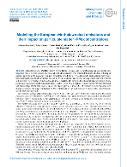Modelling the European wind-blown dust emissions and their impact on particulate matter (PM) concentrations

Autor
Liaskoni, Marina Despoina
Bartík, Lukáš
Datum vydání
2023Publikováno v
Atmospheric Chemistry and PhysicsRočník / Číslo vydání
23 (6)ISBN / ISSN
ISSN: 1680-7316Metadata
Zobrazit celý záznamKolekce
Tato publikace má vydavatelskou verzi s DOI 10.5194/acp-23-3629-2023
Abstrakt
Wind-blown dust (WBD) emitted by the Earth's surface due to sandblasting can potentially have important effects on both climate and human health via interaction with solar and thermal radiation, reducing air quality. Apart from the main dust "centres" around the world, like deserts, dust can be emitted from partly vegetated mid- and high-latitude areas like Europe if certain conditions are suitable (strong winds, bare soil, reduced soil moisture, etc.). Using a wind-blown dust model (WBDUST) along with a chemical transport model (Comprehensive Air-quality model with Extensions, CAMx) coupled to a regional climate model (Weather Research and Forecasting, WRF), this study is one of the first to provide a model-based estimate of such emissions over Europe as well as the long-term impact of WBD emissions on the total particulate matter (PM) concentrations for the 2007-2016 period. We estimated average WBD emissions of about 0.5 and 1.5 Mgyr-1km(-2) in fine and coarse modes. Maximum emissions occur over Germany, where the average seasonal fine- and coarse-mode emission flux can reach 0.5 and 1 gs-1km(-2), respectively. Large variability is seen in the averaged daily emissions with values of up to 2 gs-1km(-2) for the coarse-mode aerosol on selected days. The WBD emissions increased the modelled winter PM2.5 and PM10 concentrations by up to 10 and 20 mu gm(-3), respectively, especially over Germany, where the highest emissions occur. The impact on other seasons is lower. Much higher impacts are modelled, however, on selected days when occasionally the urban PM2.5 and PM10 concentrations are increased by more than 50 and 100 mu gm(-3). The comparison with measurements revealed that if WBD is considered, the summer biases are reduced; however, the winter PM is overestimated even more greatly (so the bias increases). We identified a strong overestimation of the modelled wind speed (the maximum daily wind is almost 2 times higher in WRF than the measured ones) suggesting that WBD emissions are also overestimated - hence the enhanced winter PM biases. Moreover, we investigated the secondary impacts of the crustal composition of fine WBD particles on secondary inorganic aerosol (SIA): sulfates (PSO4), nitrates (PNO3) and ammonium (PNH4). Because the water pH value, and thus the uptake of the gaseous precursors of SIA, is perturbed and because the increased aerosol surface serves as an oxidation site, we modelled seasonal PSO4 and PNO3 concentrations increased by up to 0.1 mu gm(-3) and PNH4 ones decreased by up to -0.05 mu gm(-3), especially during winter. In terms of average daily impact, these numbers can, however, reach much larger values of up to 1-2 mu gm(-3) for sulfates and nitrates, while the decrease in ammonium due to WBD can reach -1 mu gm(-3) on selected days. The sensitivity test on the choice of the inorganic equilibrium model (ISORROPIA vs. EQuilibrium Simplified Aerosol Model V4, EQSAM) showed that if EQSAM is used, the impact on SIA is slightly stronger (by a few 10 %) due to larger number of cations considered for water pH in EQSAM. Our results have to be regarded as a first estimate of the long-term WBD emissions and the related effects on PM over Europe. Due to the strong positive wind bias and hence strong WBD emissions, we should consider these results as an upper bound.
Klíčová slova
Modelling, European, wind-blown dust, emissions, particulate matter
Trvalý odkaz
https://hdl.handle.net/20.500.14178/2294Licence
Licence pro užití plného textu výsledku: Creative Commons Uveďte původ 4.0 International





